Do you want to develop well-defined tricep and chest muscles and strengthen your upper body at the same time? Dumbbell workouts might be the solution you’ve been looking for when it comes to your fitness regimen. We’ll go over the advantages, methods, and best practices for a dumbbell chest and tricep workout in this extensive tutorial.
Why You Should Train Your Chest and Triceps Together
Training chest and tricep together offers several benefits, including muscle synergy, time efficiency, frequency, compound movements, balanced development, and variety.
By combining chest and triceps exercises, you can maximize the efficiency of your workout, save time, and target both muscle groups more frequently. Compound movements, such as bench press variations, can effectively target both muscle groups in a single exercise.
Strengthening your upper body muscles through training is beneficial to both your physical appearance and strength. Performing separate workouts with dumbbells for your triceps and chest during a workout adds variety to your programme and keeps your muscles from deteriorating.
It’s beneficial since it makes better use of your time, engages those muscles more frequently, and ensures that they develop collectively into strong ones. Hence, a dumbbell chest and tricep workout is a fantastic method for anyone looking to get stronger and more attractive.
Benefits of Dumbbell Chest and Tricep Workout
Dumbbell workout for the tricep and chest might help you with a number of issues.
- Greater Stabilisation Needed: Compared to machine-based exercises, dumbbell movements need more stabilisation, which results in higher muscle activation. Greater strength and muscle growth may come from this.
- Better Symmetry and Balance: Since dumbbells allow for the separate movement of each arm, they can be used to resolve asymmetries or strength imbalances between the triceps and chest muscles.
- Versatility: Dumbbells can be used for various chest and triceps exercises, allowing for adjustments in grip, angle, and range of motion to target different muscle fibers and ensure continuous growth.
- Functional Strength: Exercises with dumbbells more closely resemble natural movements than those using machines, enhancing functional strength that is applicable to everyday tasks and athletic performance.
- Improved Core Strength and Stability: Several dumbbell movements for the chest and triceps activate the core muscles to keep the body stable during the activity.
- Convenience and Accessibility: You can easily work out your chest and triceps at home or in a variety of gym settings using dumbbells because they are accessible and reasonably priced.
- Injury Prevention: workouts with dumbbells provide a more natural range of motion, which lowers the chance of injury as compared to workouts done on stationary machines with preset movement patterns.
- Progressive Overload: Over time, progressive overload can be used to continuously challenge and drive muscular growth because dumbbells provide the flexibility to increase weight slowly.
Dumbbell workouts for chest and triceps build stronger, evenly distributed muscles, improve daily task function, and prevent injuries, making them a beneficial addition to any training regimen.
Top 10 Dumbbell Chest and Tricep Exercises
Bridge Chest Fly
The Bridge Chest Fly is a useful exercise that works the core and glutes in addition to the chest muscles. You can increase the difficulty and efficacy of this exercise by combining a bridge action with a chest fly.
How to do it:
- Start by reclining on a mat or bench with your back flat. With your feet flat on the ground and hip-width apart, bend your knees. Dumbbells should be held in each hand, palms facing inward towards one another. With your elbows slightly bent, raise your arms straight above your chest.
- Pull your navel in towards your spine to activate your core muscles. Throughout the activity, this will support and stabilise your spine and safeguard your lower back.
- By applying pressure through your heels and using your hamstrings and glutes to form a bridge position, raise your hips off the floor. From your shoulders to your knees, your body should make a straight line.
- Keep your elbows slightly bent as you slowly descend your arms in a wide arc, maintaining the bridge posture. Dumbbells should be lowered until your arms are parallel to the floor or just below shoulder height. As you drop the weights, your chest muscles should feel stretched.
- At the bottom of the action, pause for a while and concentrate on maintaining tension in your chest muscles by squeezing them.
- With your elbows slightly bent, contract your chest muscles to raise the dumbbells back to the starting position. As you press the weights back up, concentrate on tightening your chest muscles.
- Keeping control and appropriate form the entire time, repeat the exercise for the desired number of times.
Decline Push-Up
A more difficult version of the standard push-up that works the muscles in the lower chest as well as the shoulders, triceps, and core is the Decline Push-Up. Here is a detailed tutorial on how to carry it out:
How to do it:
- Set Up: Locate a stable raised area for your feet to rest, like a step, bench, or plyometric box. Make sure everything is safe and sturdy.
- Assume the Push-Up arrange: To begin, arrange yourself in a plank position with your hands directly under your shoulders, slightly wider than shoulder-width apart. The line connecting your head to your heels should be the shape of your body.
- Raise Your Feet: Plant your feet with your toes resting on the edge of the raised area behind you. There’s more challenge at higher elevations.
- Engage Your Core: To keep your plank position steady throughout the exercise, tighten your abdominal muscles and compress your glutes.
- Lower Your torso: Breathe in while lowering your chest gradually towards the floor, maintaining a 45-degree angle between your elbows and your torso. Keeping your body in a straight line from head to heels, lower yourself until your chest almost touches the floor.
- Push Back Up: To raise your body back to the beginning posture, release your breath while you press through your hands and stretch your arms. Throughout the exercise, keep your head to heels in a straight line and keep your core active.
- Repeat: Carry out the targeted quantity of reps, focusing on deliberate and fluid motions. With every repeat, pay close attention to using your triceps, shoulders, and chest.
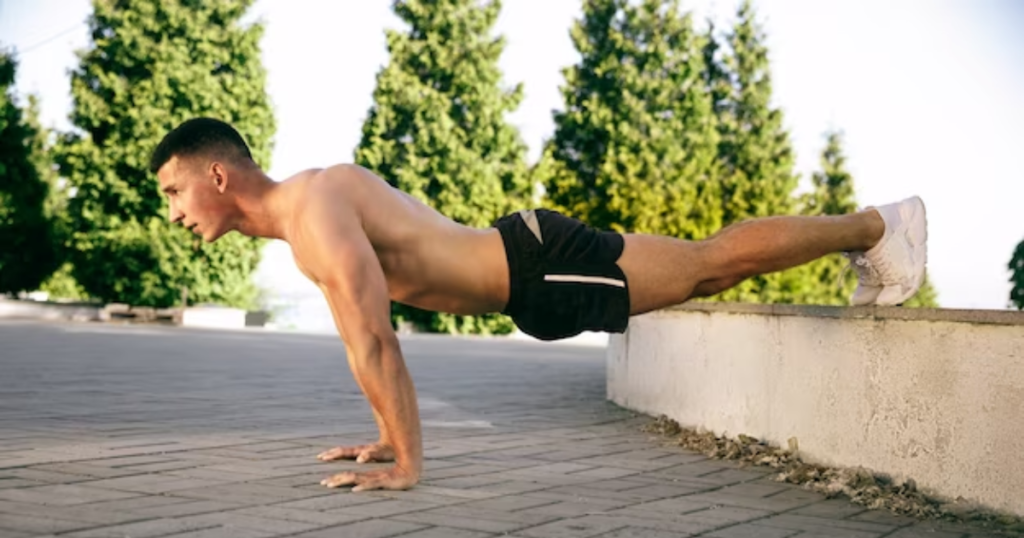
Incline Dumbbell Press
A super cool exercise for making your upper chest muscles strong is the Incline Dumbbell Press. It’s like doing push-ups, but you lie on a slope and lift dumbbells up and down. This helps grow your chest wide. Plus, it’s a neat change from regular dumbbell presses because it works your muscles from a different angle.
When you do this exercise, you’re not only making your chest stronger, but also giving a good workout to your triceps (those muscles on the back of your arms) and shoulders. So, it’s like hitting two birds with one stone a great dumbbell chest and tricep workout!
How to do it:
- Configure the Bench: Set an inclined bench at a roughly 30- to 45-degree angle. Before beginning, make sure the bench is sturdy and secure.
- Dumbbell Selection: Pick a set of dumbbells that you can lift with good form. If you’re new to the activity, start with lesser weights and work your way up to a heavier weight as you get more comfortable.
- Place Yourself: Lean back against the backrest while seated on the inclined bench. With your hands pointing forward, hold a dumbbell at shoulder height in each hand. For stability, place your feet flat on the ground.
- Engage Your Core: To keep your body stable during the workout, tense your core muscles. This keeps the lower back from too arching and helps to maintain good form.
- Commence the Press: Release your breath as you raise the dumbbells, fully extending your arms without locking your elbows at the peak of the exercise. Maintain a straight wrist alignment with your forearms.
- Control the Descent: Take a breath and keep your breathing controlled as you gradually bring the dumbbells back down to the beginning position. Reduce the weights until your elbows are just below shoulder height and your chest muscles start to stretch.
- Maintain Correct Form: To prevent shrugging, keep your shoulders back and down during the exercise. For maximum muscular activation, elevate your chest and slightly push your shoulder blades together.
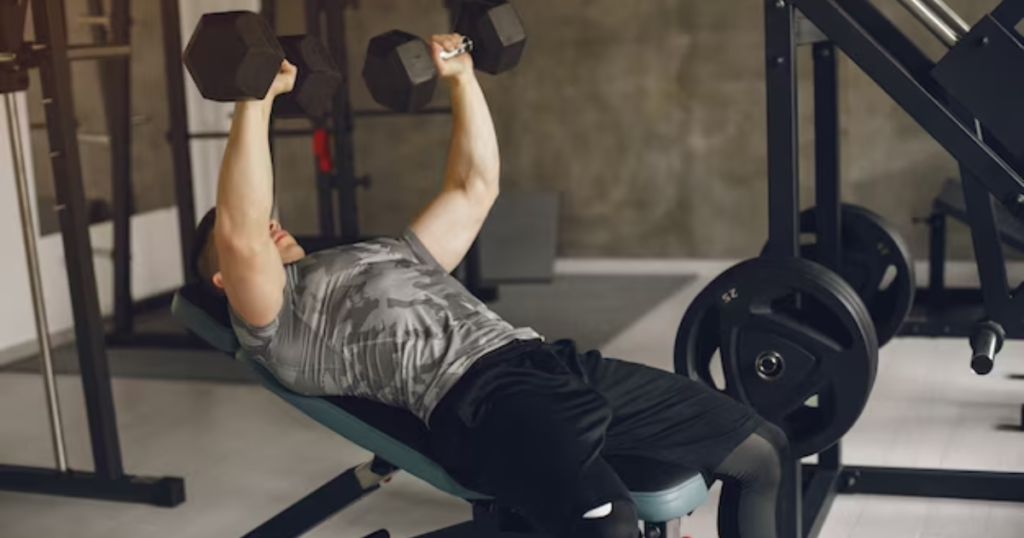
Decline Dumbbell Press
One of the best exercises for strengthening the muscles in your lower chest is the Decline Dumbbell Press. Here is a detailed tutorial on how to carry it out:
How to do it:
- Establish the Bench: Set a decline bench at a 15–30 degree angle below horizontal. Ascertain the bench’s stability and security.
- Picking the Dumbbells: Pick a set of dumbbells that you can lift with ease and correct form. If you are unfamiliar with the exercise, start with lesser weights.
- Lie Down: With your feet firmly planted beneath the foot pads or hooked at the top of the bench, lie faceup on the decline bench. With your hands pointing forward, hold a dumbbell at shoulder height in each hand.
- Engage Your Core: To keep your body stable during the workout, tense your core muscles. For ideal alignment, keep your back flat against the bench.
- Start the Press: Press the dumbbells upward while exhaling, fully extending your arms without locking your elbows at the top. Maintain a straight wrist alignment with your forearms.
- Control the Descent: Take a breath and keep your breathing controlled as you gradually bring the dumbbells back down to the beginning position. The goal is to lower the weights until your elbows are just little shorter than your shoulders.
- Preserve Correct Form: To prevent shrugging, keep your shoulders back and down the entire time. You should elevate your chest and slightly push your shoulder blades together.
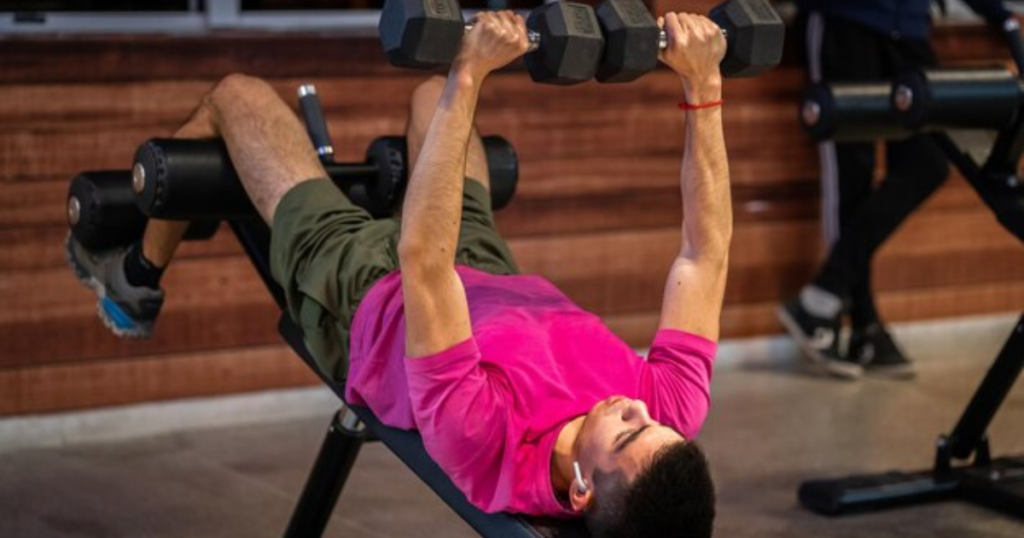
Dumbbell Bench Press
Do you want to develop powerful chest and arm muscles? Try the dumbbell bench press, a basic exercise. It strengthens the muscles in your chest, shoulders, and triceps. Let’s see how to properly perform this dumbbell workout for the tricep and chest.
How to do it:
- Setup: Take a seat on a level bench and hold a dumbbell in each hand to start. Stretch out on the bench and position the dumbbells on your thighs. Place the dumbbells shoulder-width apart and face forward with your palms.
- Grip: Make sure the dumbbells are sturdy and not swaying by holding them firmly and securely. You should have a straight wrist with your thumbs encircling the handles.
- Positioning: Make sure your feet are firmly planted and spaced comfortably apart. To ensure stability during the exercise, keep your back flat on the bench and contract your core muscles.
- Pressing Motion: Until your arms are fully stretched but not locked out, exhale as you press the dumbbells upward. Throughout the exercise, maintain the dumbbells precisely above your shoulders while bending your elbows just a little bit.
- Controlled Descent: Breathe in while gradually bringing the dumbbells back up to your chest while keeping your form. Dumbbells should be lowered until your upper arms are parallel to the floor or until your chest muscles start to stretch.
- Elbow Position: Make sure your elbows are at a comfortable angle, neither too tight to your body nor too far away from it. This lessens the tension on the shoulders while effectively targeting the muscles in the chest.
- Range of Motion: Try to move through your whole range of motion while keeping your form correct. Steer clear of utilising momentum to lift the weights or bouncing them off your chest. In order to reduce the chance of injury and maximise muscle engagement, concentrate on deliberate movements.
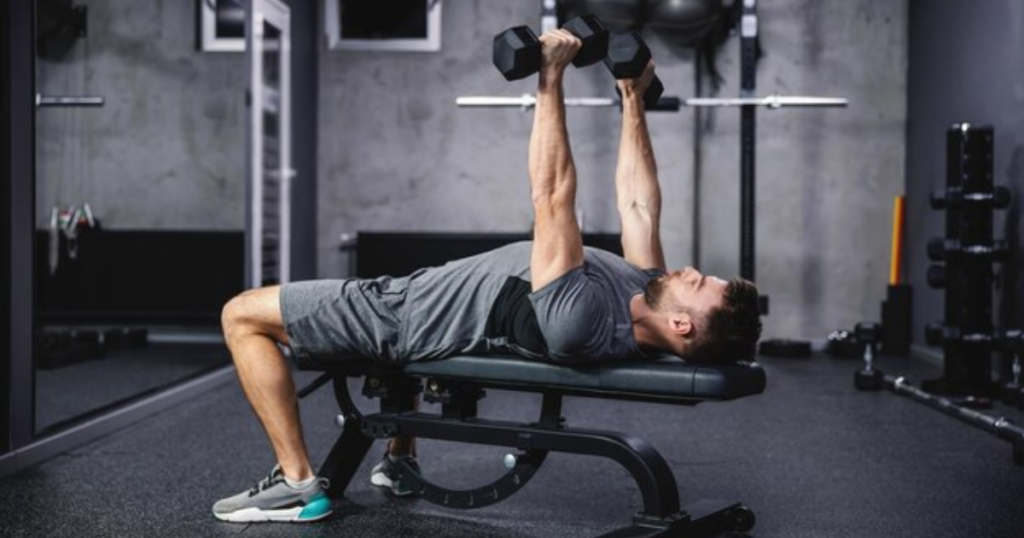
Reverse Lunge Curl Kickback
This compound exercise, known as the Reverse Lunge Curl Kickback, works the quadriceps, hamstrings, glutes, biceps, and triceps. Here is a detailed tutorial on how to carry it out:
How to do it:
- Start Tall: Place your feet hip-width apart and stand erect. With your arms out to the fullest at your sides, grasp a set of dumbbells with your palms facing inward.
- stride Back: Using your right foot, take a big stride backward and land on the ball of your foot. Make sure your front knee stays in line with your ankle and doesn’t extend past your toes as you lower your body until both knees are bent at a ninety-degree angle. The rear knee should be slightly elevated above the floor.
- Curl: Lift the dumbbells towards your shoulders and bend your elbows to execute a bicep curl at the same time as you lunge back. Throughout the exercise, keep your elbows close to your sides and concentrate on flexing your biceps.
- Kickback: To execute a tricep kickback, stretch your arms straight behind you once you’ve reached the bottom of the lunge position. Squeeze your triceps at the peak of the exercise while completely extending your elbows and keeping your upper arms parallel to the ground.
- Return to Starting Position: Step forward with your right foot to bring yourself back to the beginning position. To reverse the action, push through the heel of your front foot. Lower the dumbbells back to your sides at the same moment.
- Repeat on the Other Side: Follow the same steps, but take a step back with your left foot this time. For the necessary amount of repetitions, switch between legs.
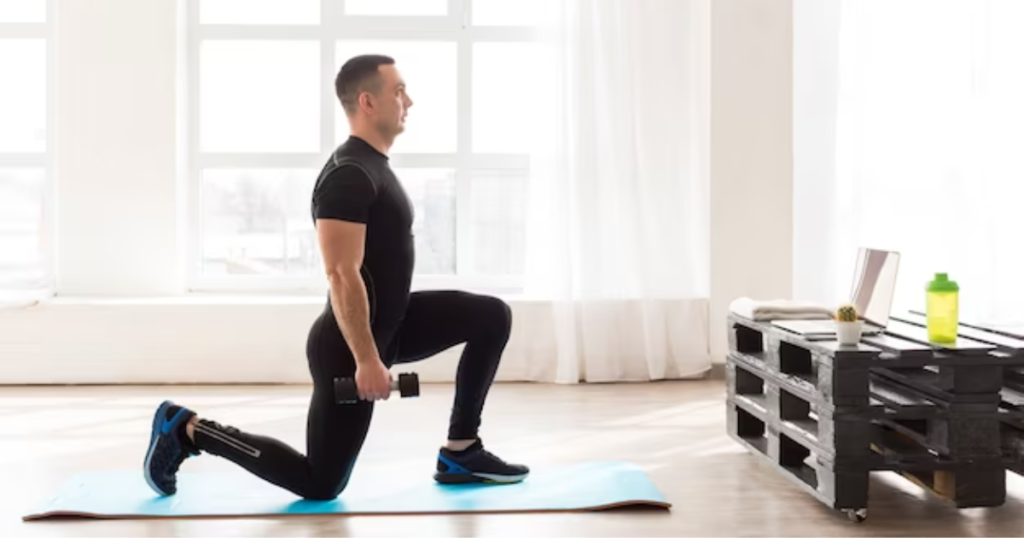
Skull Crusher Press
The Skull Crusher Press is a well-liked exercise routine to build stronger arm muscles. Another name for it is the “lying triceps extension.” You may work out your tricep and chest with dumbbell by doing this workout. Let’s get the hang of it properly!
How to do it:
- Setup: Lie flat on a bench with your back completely supported to start. Hold a straight barbell or an EZ bar with an overhand grip, hands shoulder-width apart. With your elbows slightly bent, fully extend your arms above your chest.
- Positioning: To keep your body stable during the workout, contract your core muscles. For balance, place your feet level on the ground. As you look up, make sure your head is resting gently on the bench.
- Lower the Bar: Holding your upper arms perpendicular to the floor, steadily lower the bar towards your forehead while inhaling. Throughout the exercise, your elbows should stay pointed towards the ceiling.
- Control the Descent: Keep your grip on the bar and lower it until it is slightly over your forehead. Refrain from letting your elbows stretch out to the sides as this can put undue strain on your shoulders.
- Press Up: Let out a breath as you raise the bar back to the beginning position, completely extending your arms without locking out your elbows. Throughout the exercise, maintain a straight wrist and alignment with your forearms.
- Keep Your Elbows in Check: Throughout the workout, make sure your elbows stay fixed and pointed upward. This minimises undue strain on the elbow joints and aids in isolating the triceps muscles.
- Repeat: Carry out the required number of reps, being sure to maintain a steady and fluid action during each rep. To maximise muscle engagement, concentrate on squeezing the triceps muscles at the apex of the exercise.
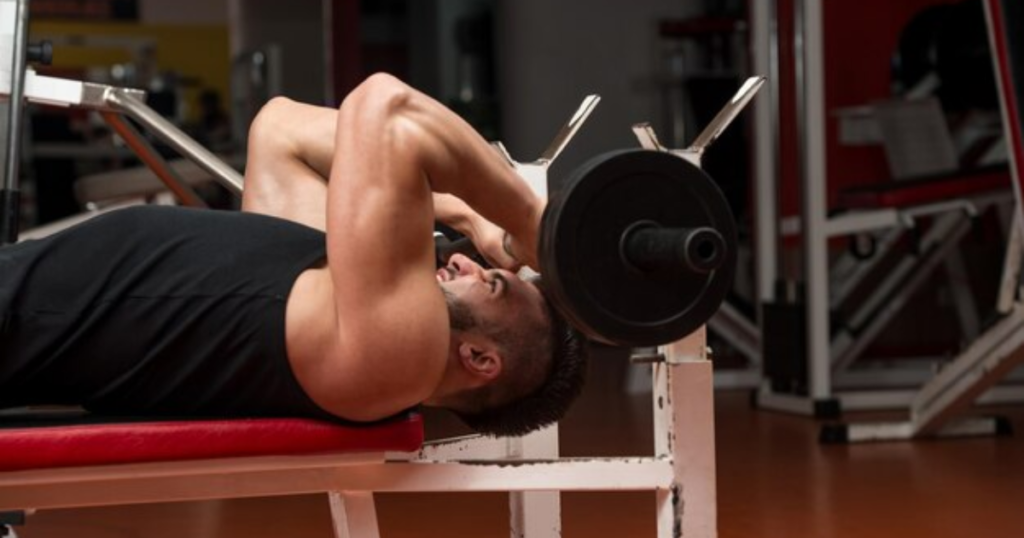
Overhead Triceps Extension
The triceps muscles are found on the back of the upper arm, and the Overhead Triceps Extension is a useful exercise for targeting them. Here is a detailed tutorial on how to carry it out:
How to do it:
- Decide on the Weight: Select a dumbbell or appropriate weight plate that you can lift and manage with ease. If you are unfamiliar with the exercise, start with lesser weights.
- Standing or Sitting: This exercise can be done either way, with a bench serving as your seat. When seated, make sure the backrest is properly positioned to support your back and the bench is firm.
- Hold the Weight: Using an overhand grip, take hold of one end of the dumbbell or weight plate with both hands. Your palms should be facing up and your hands should be close together.
- Position the Weight: Raise the weight over your head and extend your arms all the way to the point where they are parallel to the floor. Throughout the workout, keep your upper arms still and your elbows close to your head.
- Engage Your Core: To help you stay balanced and stabilise your body, tense your core muscles. If you are seated, keep your feet flat on the floor; if you are standing, keep your feet firmly planted in the ground.
- Lower the Weight: Take a breath and bend your elbows so they point upward as you gradually lower the weight behind your head. Throughout the exercise, keep your upper arms near to your head.
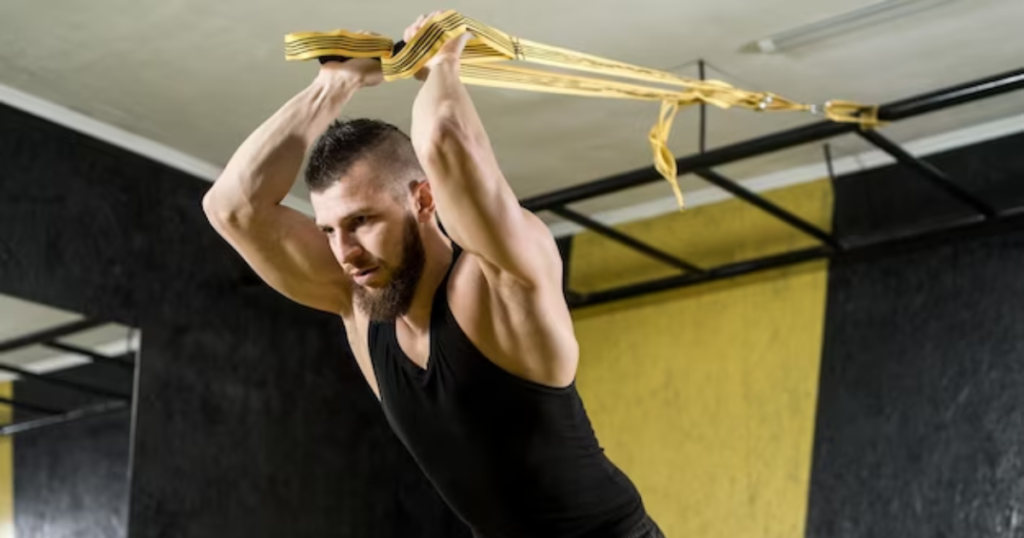
Rope Push Down
A good exercise to work the triceps muscles is the rope push down. Here is a detailed tutorial on how to carry it out:
How to do it:
- Set Up the Cable Machine: To set up a cable machine, fasten a rope handle to the machine’s high pulley. Ensure that the resistance level of the weight stack is suitable for your current level of fitness.
- Adjust the Position: To adjust the position, stand with your feet shoulder-width apart and face the cable machine. With your palms facing down, take an overhand grip on the rope handle and hold it tightly with your hands.
- Engage Your Core: To keep your body stable during the workout, tense your core muscles. Maintain a straight back, shoulders back, and chest up.
- Start the Movement: Keep your upper arms close to your sides and your elbows bent at a 90-degree angle to start. The ground should be parallel to your forearms.
- Push Down: Let out a breath and press the rope handle down towards the ground with your elbows. At the bottom of the exercise, avoid locking out your elbows and fully extend your arms.
- Squeeze the Triceps: At the bottom of the exercise, take a small break and firmly tense your triceps. Pay attention to the strain in your triceps.
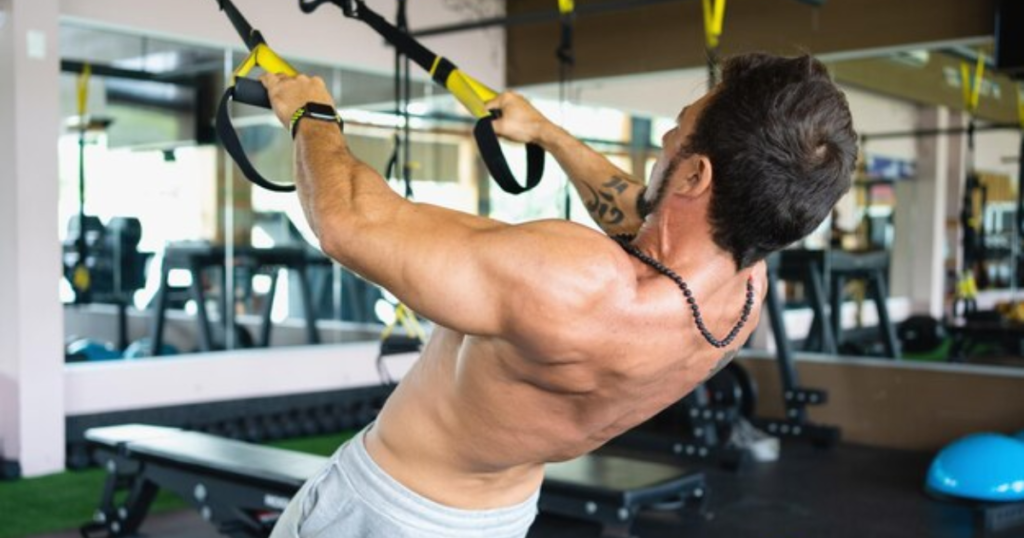
Tower Dip
For the Tower Dip, also known as parallel bar dips, people frequently use parallel bars or dip bars. The shoulders, triceps, and chest can all be strengthened with this workout.
It’s similar to working out your tricep and chest with dumbbell workout without the need for weights. To perform it successfully, your upper body must be powerful and steady.
How to do it:
Configuration:
- Place yourself in the space between two dip or parallel bars. Make sure the bars are firmly fixed to the ground or a strong structure.
- With your hands somewhat wider than shoulder-width apart, firmly grasp each bar. You should be holding your palms inside, towards your body.
Initial Position:
- With your arms extended and your body raised off the ground, leap or step up to hold yourself on the bars. Your body should be perpendicular to the ground, and your arms should be completely extended.
- Throughout the workout, keep your chest up, your shoulders back, and your core active.
Decline:
- Bend your elbows and let them stretch out to the sides to lower your body. Lower yourself until your elbows make about a 90-degree angle and your upper arms are either parallel to the ground or slightly below.
- Steer clear of excessive forward or backward leaning by keeping your body erect.
Ascend:
- To raise yourself back up to the beginning position, press through your hands and extend your arms. Instead of pointing your elbows straight to the sides, keep them pointing slightly behind you.
- Breathe out as you raise yourself up, using your shoulders, triceps and chest to finish the exercise.
Again:
- Execute the targeted quantity of reps, concentrating on precise motions and upholding appropriate form.
- Throughout the workout, try to keep your pace smooth and steady; don’t swing or use your momentum to get yourself up.
Recool:
- After your set is over, gradually lower yourself off the bars to give your muscles time to cool down.
- Stretches that open up the chest, triceps, and shoulders could help you become more flexible and loosen up your muscles.
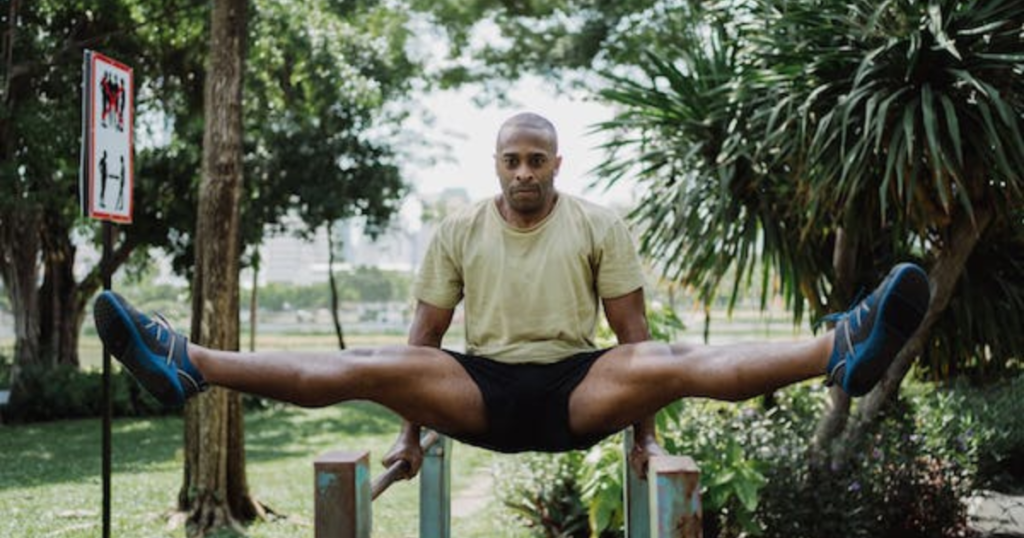
Best Workout Routine For Chest and Tricep
A combination of compound and isolation exercises can make up an excellent training programme for successfully targeting the chest and triceps. There is a routine for chest and tricep:
Warm-up:
- 5–10 minutes of mild aerobic exercise (jumping jacks, cycling, jogging)
- Arm circles and chest openers are examples of dynamic triceps and chest stretches.
Press Bench:
- 4 sets of 8–10 repetitions
- Choose a weight that will push you while still enabling you to complete each set with correct form.
Dumbbell Press on an Incline:
- 3 sets of 10–12 repetitions
- The bench should be tilted between 30 and 45 degrees.
- Maintain control and a full range of motion throughout the exercise.
Flyes on the chest:
- 3 sets of 12–15 repetitions
- Employ cables or dumbbells, bending your elbows slightly during the exercise.
- Concentrate on the chest muscles’ stretches and contractions.
Dips in the Triceps:
- 3 sets of 10–12 repetitions
- Use a strong bench or parallel bars.
- When your elbows are at a 90-degree angle, keep your body straight and push yourself back up.
Extension of the Tricep Overhead:
- 3 sets of 12–15 repetitions
- For this workout, you can use a dumbbell or cable.
- Lift your arms straight up above your head, keeping your elbows close to your head.
Pushdown with Cable Triceps:
- 3 sets of 12–15 repetitions
- Fasten a rope or straight attachment to a high pulley.
- As you fully extend your arms downward, keep your elbows close to your sides.
Push-ups (Finisher Optional):
- Two sets times the maximum repetitions
- To further exhaust the chest and triceps, push yourself to the limit or nearly there with conventional push-ups.
Cool Down:
- Spend five to ten minutes focusing on your shoulders, triceps, and chest when you stretch.
- Incorporate static stretches like the shoulder, tricep, and chest stretches.
Common Mistakes to Avoid
To maximise performance and prevent damage, it’s crucial to avoid frequent mistakes when completing dumbbell chest and tricep workouts. The following are some errors to be aware of:
- Using Too Much Weight: Using excessively heavy weights can lead to form problems and a higher chance of injury. Before progressively increasing the weight, start with smaller weights and concentrate on using the right technique.
- Inadequate Range of Motion: Muscle activation and growth may be restricted when exercises are not completed over their entire range of motion. Make sure that with every repetition, you are lowering the weights all the way and extending your arms to their maximum length.
- Bad Posture: In order to target the targeted muscles and avoid straining other portions of the body, it is imperative to maintain good posture. Maintain a straight back, downcast shoulders, and back.
- Rounded Shoulders: When performing exercises for the chest, allowing your shoulders to curve forward can take attention away from the chest muscles and raise the possibility of shoulder injury. With each repeat, maintain your shoulders back and down while concentrating on tightening your chest muscles.
- Elbow Flaring Out: When performing chest exercises, allowing your elbows to flare out to the sides might cause undue strain on your shoulder joints and reduce the exercise’s effectiveness. To more efficiently target the muscles in your chest, keep your elbows slightly angled towards your torso.
You may maximise the results and lower the risk of damage from your dumbbell chest and tricep workouts by avoiding these frequent blunders and concentrating on appropriate form and technique.
To make sure that you’re doing exercises correctly, if you’re not confident about your technique, think considering working with a certified personal trainer.
Modifications for Beginners
Lighter Weights
If you’ve never done strength training before, begin with lower weights so you can concentrate on learning the right form and technique before progressively adding resistance. This lessens the possibility of injury and permits a more progressive increase in muscle mass and strength.
Simplified Exercises
Starting with easier exercises like push-ups instead of using heavy weights for bench presses or doing tricep kickbacks instead of stretching your arms overhead can be super helpful if you’re just starting out.
As you get stronger and more sure of yourself, you can try fancier versions of these exercises. So, if you’re doing a dumbbell chest and tricep workout, it’s smart to start simple and work your way up to the tougher moves.
Read More: 10 Main Signs of Gaining Muscle and Losing Fat
Conclusion
Dumbbell workouts for the chest and triceps can strengthen your upper body, improve the contour of your muscles, and improve your general health. For the finest dumbbell chest and tricep workout, make sure you’re performing the exercises correctly, start out slowly and work your way up to more difficult exercises, and don’t forget to eat healthily and get enough sleep. You’ll get in better and faster shape if you do this.
Frequently Asked Questions
Dumbbell exercises for the chest and triceps are what?
Workouts with dumbbells for the chest and triceps help you develop the muscles and strength in these areas. Typical exercises for these muscles include flyes, tricep extensions, and chest presses.
Why should I work out my triceps and chest with dumbbells?
Exercises using dumbbells for the chest and triceps are excellent for building upper body strength. They enhance your general strength, help you develop muscle, and assist you maintain better posture. Additionally, they can facilitate everyday tasks like carrying groceries or participating in sports.
How often should I work out my triceps and chest using dumbbells?
It is advised to perform dumbbell exercises for the triceps and chest two to three times a week. It’s critical to allow your muscles to rest and recuperate in between workouts if you want to notice improvements and avoid damage. Recall that consistency is essential!
Can I work out my triceps and chest with dumbbells at home?
Yes, without a doubt! If you have a set of dumbbells and enough room to move about comfortably, you can work out your triceps and chest with them at home. You may find a lot of videos and online tools that will walk you through various routines and exercises.
Can beginners perform dumbbell workouts for their chest and triceps?
Indeed, they are! All fitness levels, especially beginners, can benefit from dumbbell exercises for the chest and triceps. To prevent injury, start with smaller weights and concentrate on good form. You can progressively raise the weight and intensity of your workouts as you gain stronger and more at ease. Recall that it’s acceptable to take your time and advance at your own speed!

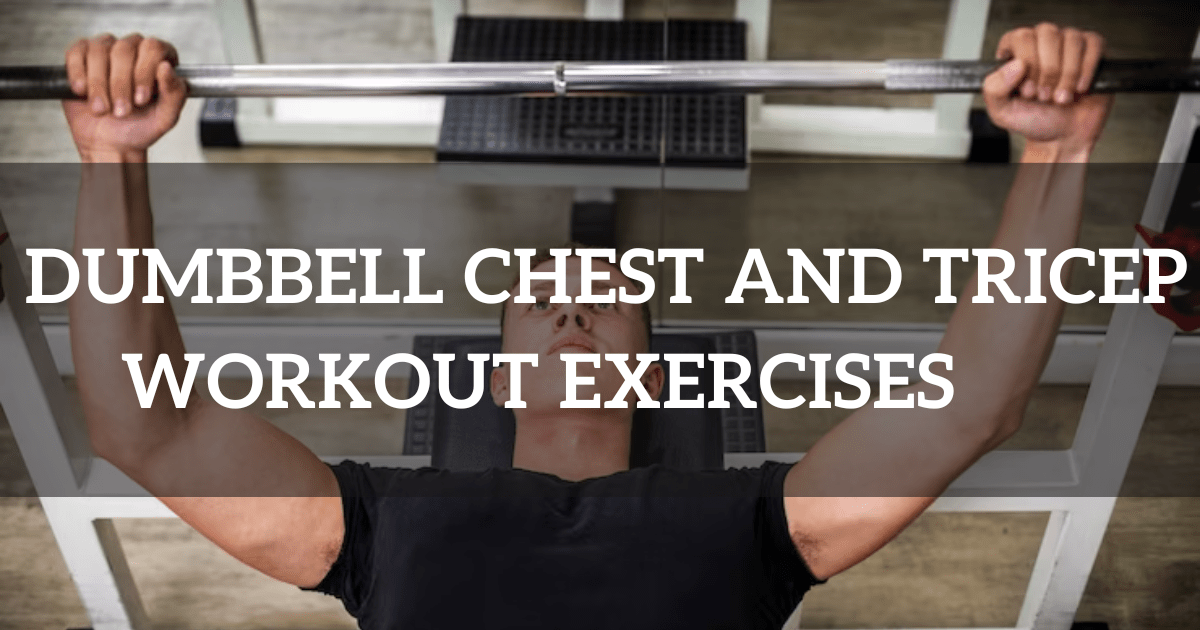







Leave a Reply